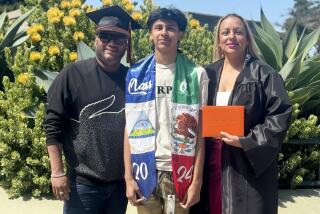Video of Gardena shooting a rare view into police tactics under stress
- Share via
As their patrol car video cameras rolled, the Gardena police officers jumped out, lined up and lifted their handguns.
The officers can be seen in the recordings ordering three men to raise their hands. But one man lowered his, raised them, extended empty palms toward the officers, then pulled off his baseball cap and lowered both arms to his side.
As he began to raise his hands again, the officers opened fire almost simultaneously, and the unarmed man crumpled to the ground.
Los Angeles County prosecutors concluded that the officers didn’t commit a crime and the Gardena Police Department decided they did not deserve to be disciplined as a result of the June 2, 2013, shooting. But with the videos now public, several experts on police use of force questioned some of the officers’ tactics and wondered whether the shooting could have been avoided.
“It is hard to see what threat was posed to these officers,” said Geoffrey Alpert, a University of South Carolina professor of criminology who studies police tactics and shootings. “It doesn’t look good in terms of the training of these officers.”
The videos, released under order of a federal judge Tuesday, were viewed by millions across the world, opening an intense and rare view of police tactics under stress and fueling an already roiling national debate over the use of lethal force by law enforcement.
Interpretations of what the recordings show were as fractured as the larger debate.
Although a massive reaction on social media leaned toward revulsion at what appeared a heartless execution, policing experts differed on basic questions raised by the videos: Were the officers following training or acting upon reflex? Did they all fire simultaneously — perceiving the same threatening movement — or did one officer’s decision to shoot prompt the others to open fire? Was the shooting justified or not?
Law enforcement officers are trained that they can use deadly force if they believe their lives or the lives of others are threatened. But the law looks favorably on decisions police officers make in the heat of the moment.
“I would have to say the majority of officers would not have shot in this case,” said Ed Obayashi, a sheriff’s deputy in Northern California and an attorney who advises several counties on use of force.
Obayashi said the videos reveal serious tactical flaws leading to “the worst impression of an unreasonable shooting.” He said the officers should have taken cover behind their vehicles before confronting the men, whom they mistakenly believed were robbery suspects. Failing to take cover “heightened their concern about their safety and need for deadly force.”
“This is a scenario you see in simulators all the time,” Obayashi said.
In contrast, Charles “Sid” Heal, a former L.A. County sheriff’s commander who is president of the California Assn. of Tactical Officers, said the officers had a reasonable fear that the man raising and lowering his hands was armed as they responded to what turned out to be an erroneous radio dispatch of a robbery. The officers said they could not see the man’s right hand when they opened fire and feared he was reaching for a weapon.
Heal credits the matter-of-fact quality of the video for illuminating the little-understood reality of police work.
“The public has developed an unrealistic frame of reference of police work, almost certainly by watching scripted television shows and even reality shows that omit the blood,” he said. “This sheltered view of reality has created a false perception that makes everyone an expert in police work without a realistic understanding of the instant changes and deadly consequences for not ‘reading’ a situation correctly.”
Gardena Police Chief Ed Medrano acknowledged Wednesday that better tactics could have been used in what he described as “a tragedy for all,” including the three officers who fired.
“They got the wrong person,” Medrano said. “They shot an unarmed man. They take no comfort in that.”
Medrano said the department’s review has been concluded and the three officers — Christopher Mendez, Christopher Sanderson and Matthew Toda — faced no discipline. The videos, he said, fairly represented the events that led the officers to suspect Ricardo Diaz Zeferino was reaching for a gun when they fatally shot him.
“They felt that the movement to the waistband was the justification for the shooting,” Medrano said.
The chief did fault the officers for stepping out in front of their vehicles rather than taking cover behind them. The department is now giving new training on how officers can de-escalate confrontations and avoid getting into dangerous situations, he said.
This year, the city reached a $4.7-million settlement of a federal civil rights lawsuit brought by the survivors and the family of Diaz Zeferino.
On Tuesday, a federal judge granted a request by The Times, the Associated Press and Bloomberg to unseal the videos over the objections of the city.
The shooting occurred after police responded to a call about a bicycle stolen from outside a CVS drugstore. A police dispatcher mistakenly told officers the crime was a robbery, which typically involves weapons or force.
A sergeant responding to the call saw two men riding bicycles near the store. Suspecting they could be the robbers, the sergeant stopped the men.
Diaz Zeferino, who was later found to have alcohol and methamphetamine in his blood, rushed up, ignoring police commands to stop. His family’s attorneys argued that he was trying to tell the officers that the two men on bikes were friends of his brother, who owned the stolen bicycle, out searching for the thieves.
In one of the videos, Diaz Zeferino ambles into the spotlight of an officer who orders him in English and Spanish to stop.
Instead, Diaz Zeferino waves his hands and approaches the two men on bikes as two more patrol vehicles arrive and three officers get out.
“Get your hands up. You’re going to get shot,” an officer shouts.
Diaz Zeferino continues raising and lowering his hands. A voice says: “Do that again and you’ll get shot.”
As Diaz Zeferino begins to raise his hands, three officers fire. The sergeant did not shoot.
The release of the video comes as law enforcement agencies nationwide increasingly have embraced the use of cameras worn by officers and placed in patrol cars to record police interactions with civilians. But few agencies have made their videos public, spurring a debate over the need to balance the privacy of those captured on the recordings and transparency in policing.
Although the videos have brought new clarity to the Gardena shooting, the differing interpretations by police force experts show the limitations of videos in providing a definitive account.
Some saw evidence of contagious fire, in which one officer fires, and, hearing the gunshots, others fire reflexively thinking someone is shooting at them. Others did not.
Wayne Fisher, a professor at the Rutgers University Police Institute in Newark, N.J., said he suspected contagious fire but said the camera angle could leave out important information.
“A police officer’s field of vision is not identical to the field of vision of the camera,” Fisher said.
But Fisher criticized the officers for yelling multiple commands from different directions that could have confused Diaz Zeferino.
Holding a news conference Wednesday, Diaz Zeferino’s brother, Agustin Reynoso, and a second man who was also hit by a police bullet that night and survived, praised the release of the video as a precedent that should be followed by law enforcement around the country.
Attorney Sonia Mercado, who represented Diaz Zeferino’s family, called on the U.S. Justice Department to investigate all fatal police shootings, starting with the Gardena killing.
“It was only when the video came out that we can all say, ‘Stop spinning the facts,’” Mercado said. “Until we were able to have the video seen by the public, the Gardena Police Department was simply spinning that their police officers had done no wrong.”
Times Staff Writers Cindy Chang, Brittny Mejia and James Queally contributed to this report.
More to Read
Sign up for Essential California
The most important California stories and recommendations in your inbox every morning.
You may occasionally receive promotional content from the Los Angeles Times.















